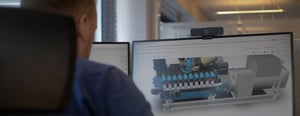
Emergency Power Categories
The four categories
Emergency power in Sweden, specifically stationary emergency power, is categorized into four different categories by Svensk Energis document "Stationära reservkraftanläggningar - Anvisning för säker drift" (only available in Swedish).
The four categories have specific scenarios and accompanying technical demands. More information about the four categories is found here on the page.
Category 1
A facility - normally fed by an incoming main - that will only connect and disconnect manually with interruption. Within this category you also find manually started mobile emergency power, connected through a switch, that powers a customer facility.
Category 2
A facility - normally fed by an incoming main - that will only connect and disconnect automatically with interruption.
Category 3
A facility - normally fed by an incoming main - that can connect and disconnect without interruption. This requires that the emergency power system is fitted with a soft transfer system that allows short transfers (≤ 1 second) where the emergency system is in parallel with the grid.
Category 4
A facility - normally fed by an incoming main - that can connect and disconnect without interruption and that is allowed to be in parallel with the grid for longer times (>1 second). The emergency power system must be able to synchronize to and from the grid without interruption and there is a demand for specific protections needed.
TN-C or TN-S
Category 1-3
The main rule is that the facility must be connected to the grid according to TN-C. If the emergency system is connected to a grid by TN-S you need a more advanced mains breaker to prevent power from running through the PE and to prevent damage to connected equipment. For mobile emergency power according to category 1 (manually connected with interruption), connected through a switch, the "good rule" is to connect it to a facility by TN-C.
Category 4
For stationary emergency power (automatic start and stop and with the possibility to run in parallel with the grid) that connects through an automatically controlled breaker the demand is that it is connected by TN-C.